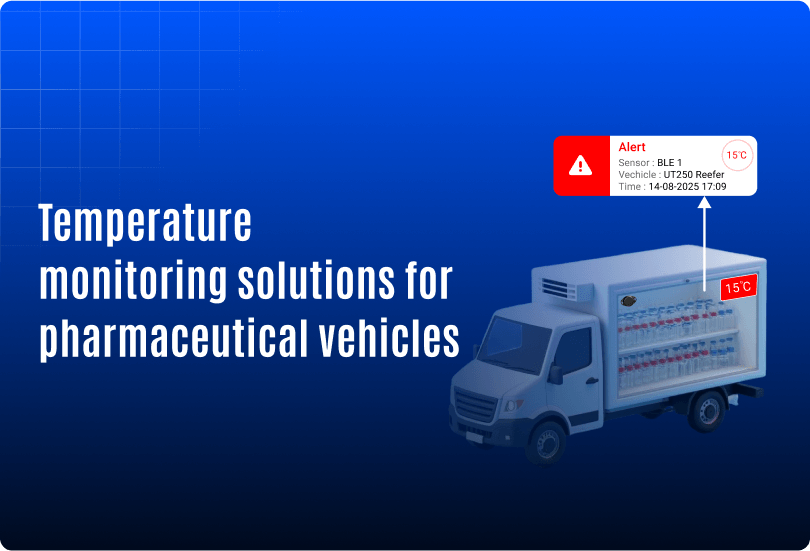Temperature Monitoring Solutions for Pharmaceutical Vehicles

The global pharmaceutical logistics market is projected to reach $146 billion by 2030, growing at a 7.8% CAGR. This growth is driven by rising demand for vaccines, biologics, and other temperature-sensitive medications. Yet, industry research shows that up to 20% of these products are lost each year due to failures in cold chain management, leading to billions in wasted inventory and serious risks to patient safety.
For pharmaceutical manufacturers and logistics providers, precise temperature control is now a regulatory mandate and key to staying competitive. With Good Distribution Practice (GDP) guidelines becoming more stringent and global supply chains more complex, real-time temperature monitoring has become essential. However, ensuring product integrity, regulatory compliance, and customer trust requires continuous and accurate monitoring throughout transit.
In this blog, we explore how advanced temperature monitoring solutions are transforming pharmaceutical transport. Consequently, these technologies are helping reduce cold chain losses and improve reliability. They enable businesses to deliver life-saving medicines with uncompromised quality from origin to destination.
The importance of temperature control in pharmaceutical transport
- Maintaining drug and safety
- Many drugs, including biologics and vaccines, are sensitive to temperature changes.
- Incorrect storage can alter chemical composition, reducing potency or causing harm.
- Active pharmaceutical ingredients (APIs) degrade outside the recommended range.
- Regulatory compliance
- FDA, EMA, and other regulators mandate strict temperature control standards.
- Good Distribution Practice (GDP) guidelines require continuous monitoring.
- Public health and safety
- Patients must receive safe, effective medicines.
- Even minor breaches can cause large-scale vaccine or drug wastage.
- Economic implications
- Temperature excursions lead to product spoilage and major financial losses.
- They can also affect insurance coverage and increase liability risks.
- Technological advances
- Growth of temperature-sensitive drugs like cell and gene therapies increases monitoring needs.
- Adoption of advanced cold chain tech real-time sensors, GPS tracking, and data logging.
- Environmental factors
- Drugs often travel across multiple climates, requiring stable temperature control.
- Focus on energy-efficient, sustainable cold chain solutions is increasing.
Temperature control is essential for drug safety, regulatory compliance, and cost prevention. As pharmaceutical and logistics technologies evolve, maintaining high cold chain standards remains a top priority worldwide.
Trends in temperature monitoring technology
The latest trends in temperature monitoring technology center on accuracy, real-time data access, and integration with existing logistical systems. These technologies include:
Wireless temperature monitoring systems: These systems provide real-time temperature data, enabling immediate response to any deviations.
GPS-enabled trackers: Offering location and temperature data, these trackers ensure transparency in the transportation process.
Cloud-based data storage and analysis: Cloud technology facilitates the remote monitoring of temperature data and also helps in predictive analytics for better risk management, including cloud contact center solutions.
Advanced alarm systems: These systems immediately notify stakeholders of any temperature breaches, allowing for swift corrective actions.
Features of our temperature monitoring solutions
Our temperature monitoring solutions for pharmaceutical vehicles are designed with precision and user friendliness in mind. Key features include:
Real-time insights & alerts
- Live temperature & humidity monitoring – Tracks conditions in real time during transit to prevent spoilage
- Immediate alerts – Notifies stakeholders via SMS, email, or the web interface when temperatures or humidity deviate from preset thresholds
Comprehensive reporting & dashboards
- Temperature reports – Provides detailed logs, including trip summaries, daily summaries, and overview dashboards—covering metrics like avg, min/max temperatures and humidity.
Customizable alerts & notifications
- Flexible threshold setting – Users can configure alerts for temperature fluctuations, humidity drifts, and battery status
Sensor & battery Integration
- Multi-sensor support – Integrates with BLE, wireless temperature sensors, RFID temperature tags, OBD data, and more, offering hardware flexibility
- Battery life monitoring – Tracks device battery levels and issues alerts when low to ensure uninterrupted monitoring
Compliance & accessibility
- Audit trail & compliance support – Automatically logs temperature and sensor data for regulatory audits and GDP compliance
- Remote access via mobile & web – Users can access dashboards, alerts, and reports from anywhere, enabling monitoring on desktops or mobile devices
Geolocation mapping
- Map-based visualization – Displays temperature data overlaid on maps featuring real-time location of the vehicle or container
Role of temperature monitoring in compliance and safety
Regulatory bodies worldwide mandate strict adherence to temperature control guidelines in pharmaceutical transport. Our temperature monitoring solutions not only assist in compliance with these regulations.They also play a critical role in safeguarding public health by ensuring that medications remain effective until they reach the consumer.
Conclusion
In pharmaceutical logistics, reliable temperature monitoring reduces losses, ensures regulatory compliance, and enhances customer confidence. Adopting advanced monitoring technology safeguards product integrity while improving operational efficiency and market competitiveness. In a sector where trust and precision define success, these solutions enable consistent, high-quality delivery from origin to destination.




